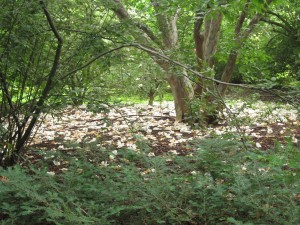
A few weeks ago, I took part in a codesign workshop in digital science and technology studies at Harvard University’s Arnold Arboretum. My team (consisting of Hanna Rose Shell, Max Liboiron, and Shad Gross) designed three data narratives about decomposition at the Arboretum.
We started our project with a sensory exploration of the Arboretum dump, “the most important production and storage site of the Arboretum,” in an intern’s words. This site allowed us to understand decomposition as a curated and regulated process: e.g., decomposing heaps are categorized; visitors are not allowed. The better curated and the more decomposed the artifacts at the dump, the more valuable and productive the mulch that they produce. Decomposition is thus integral to the well-being of the Arboretum’s collection of living organisms.
In informal conversations with Arboretum employees, we learned that certain kinds of decomposition are given priority in research: there are existing maps of soil texture, types, and nutritional info, while a future research project may investigate Arboretum’s cosmopolitan microbiomes. Employees are also aware of, but unwilling to dwell on, various other forms of decomposition related to the Arboretum’s open-door policy (such as dog-urine-soaked gates and logs).
While linear timelines may be implicit in preservation, our study of decomposition highlights the importance of cyclical time scales (weekly chipping and transport of branches designated for discard, yearly turnover of mulch piles). At the Arboretum, taking decomposition as integral to preservation allow for construction of further data narratives emphasizing the ongoing labor (of transport, curating, and maintenance of the piles) and connections with institutions and sites beyond the Arboretum (mulch from the dump is transported to the Harvard campus in Cambridge; dog-walkers come from the surrounding urban neighborhoods). By highlighting cyclical time scales, connections with other urban sites and the labor of maintenance, our project opens up new possibilities for “recomposing” the cultural and scientific significance of the Arboretum.
More broadly, our project contributes to debates about decomposition in digital collections: while decomposition has often been vilified noise or simple corruption of data, we ask whether practices of digital preservation and database design may fruitfully embrace the practices of curated decomposition.
Our final report, entitled “The Decompository,” is available on the workshop’s Tumblr page.